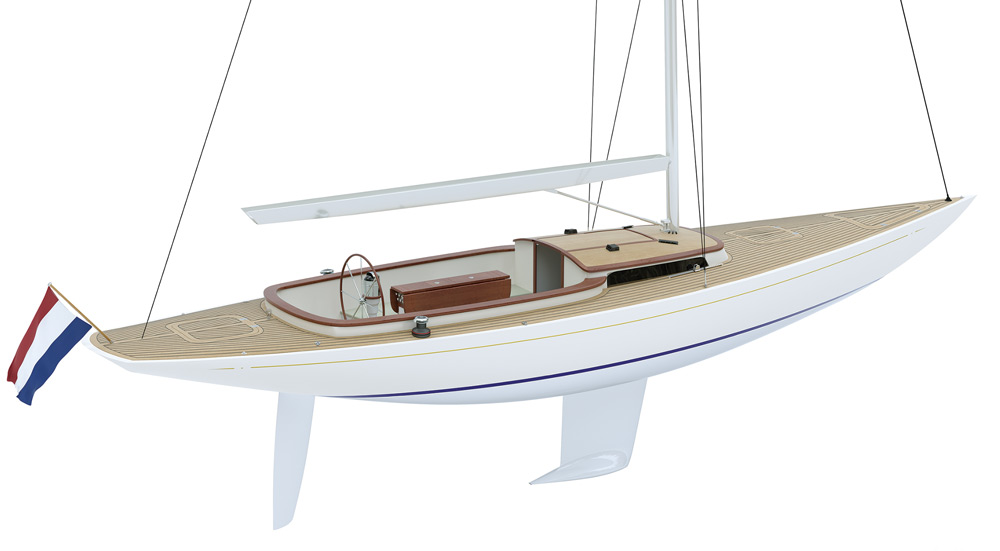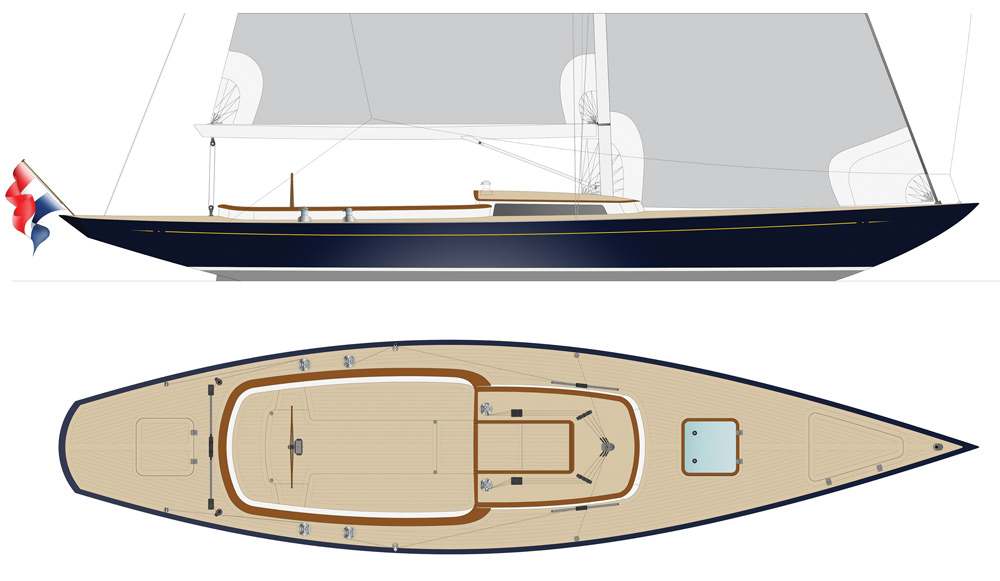Eagle 37
This new daysailer checks all the boxes in the traditional spirit category
Overhangs are in vogue these days. One of my neighbors inherited his mother’s car. The car is for sale. It’s a 1970 Cadillac Coup deVille, vomit green with a black vinyl top. It has to be the longest car I have ever seen. But the wheelbase is relatively short. Must be the lure of overhangs.
Today we see overhangs as being very traditional. But if you go back to around 1880 and watch how yacht design progressed you will quickly see that overhangs developed as a function on the various handicap or “rating” rules that came and went. Almost all the early rules up to the CCA rule penalized DWL in some way. In order to keep your rating low while gaining sailing length, call it “hull speed” if you like, overhangs were drawn out with the idea that when the boat heels more, more boat will be in the water.

But you need to make a distinction between “in the water” and “on the water.” For overhangs to contribute to sailing length at any angle of heel they must be immersed. Simply dangling some pretty parts of the boat feet above the water plane may look picturesque but it is not adding to sailing length. True, in some case overhangs can dampen pitching and make the boat faster. But that can happen at zero degrees of heel. Some overhang aft is good to clean up the wake and prevent the hull from dragging the transom as it heels.
But it’s pretty clear today that a plumb bow is faster than a bow with overhang for a given LOA. I can’t think of a case where you would want to give up static DWL. When rating rules changed to measure girths in the ends of the boat to evaluate sailing length gained, overhangs began to shrink. If you look at the box rule boats popular today you will see minimal overhangs and it’s all aft.
I can remember watching the successful America’s Cup winner Black Magic, designed by Laurie Davidson, sailing upwind, well heeled over. If you looked at the stern and how the water peeled off the counter it almost looked like they had built the boat longer. The New Zealand team went sailing and had a crewmember hang over the leeward quarter with a piece of chalk and draw a line where the water was. “Cut here!” There was no overhang aft that was not doing work.
But the appeal of overhangs today is not about these pragmatic issues. It’s all about restoring the nostalgic look of older, more graceful looking yachts, and this new Hoek design is a good example. Built by Leonardo Yachts BV in the Netherlands this graceful 37-footer shows what can and can’t be done with a long overhang design. The D/L is 190 so I would not call this a “light” boat. The beam is only 8 feet 6 inches for a L/B of 4.29 which is narrow. Draft is only 5 feet 3 inches. Given the Hoek pedigree, I’m sure this is a very nice sailing boat as long as you don’t mind sacrificing 10 feet 10 inches to overhangs.
This is a daysailer but there are minimal accommodations below. There is a V-berth. There is a quarterberth to starboard that uses some of the settee to gain the needed length for sleeping. To port there are some lockers and an exposed head. For me, having 37 feet of LOA would mean I’d like an enclosed head. While the boat is designed as a daysailer it would make a really fun cruiser for short cruises. I can see cooking on a camp stove in the cockpit if needed. I’ll go that far. But I’d like an enclosed head. Of course that would muck up the svelte cabintrunk, chew into the long cockpit and spoil the looks of the boat to some degree. Seems the designers put looks and cockpit length first. I love big cockpits.
The deck plan shows a cockpit well about 8 feet 6 inches long. That’s just the well and does not include the seat. The cockpit is T-shaped to allow room for a fairly large diameter wheel aft. The mainsheet traveler is aft of the cockpit coaming. Sheet winches are mounted on the side deck. Halyard winches are to port and starboard of the very large companionway hatch. I can’t tell how this hatch opens. It’s too long to slide forward. It would hit the mast. There is a large, flush hatch aft and another large hatch forward. There is a minimal bulwark.
With a very easily handled big rig and a SA/D of 27.14, the Eagle 37 should shoot along in light stuff making it the perfect boat for summers in the Pacific Northwest. This is a boat I could very much enjoy owning. I’ll pass on the Cadillac.
Our best estimate of the spillway price: $196,600
LOA 36’8”’; DWL 23’8”; Beam 8’6”; Draft 5’3”; Displ. 7,275 lbs.; Ballast 2,976 lbs.; Sail area 636 sq. ft. D/L 190; L/B 4.29; SA/D 27.14; Auxiliary 12-hp saildrive; Fuel 10 gal.; Water 10 gal.
Leonardo Yachts B.V.
Zwolsmanweg 5
8606 KC
Sneek, The Netherlands


Comments